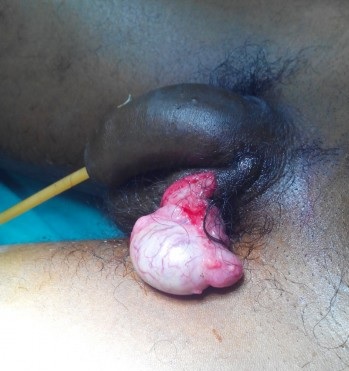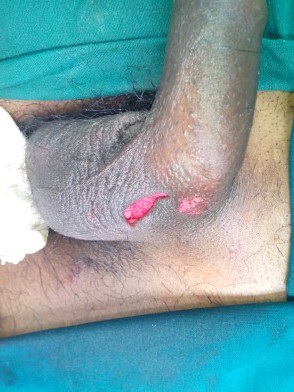Compound (External) Dislocation of Testis: An Unusual Case
Vijayakumar Chellappa1, Anitha Muthusami2, Ganesh Vijaykumar3, Sudharsanan Sundaramurthi4, TP Elamurugan5
1 Senior Resident, Department of Surgery, Jawaharlal Institute of Postgraduate Medical Education and Research, Puducherry, India.
2 Senior Resident, Department of Surgery, Jawaharlal Institute of Postgraduate Medical Education and Research, Puducherry, India.
3 Senior Resident, Department of Surgery, Jawaharlal Institute of Postgraduate Medical Education and Research, Puducherry, India.
4 Senior Resident, Department of Surgery, Jawaharlal Institute of Postgraduate Medical Education and Research, Puducherry, India.
5 Assistant Professor, Department of Surgery, Jawaharlal Institute of Postgraduate Medical Education and Research, Puducherry, India.
NAME, ADDRESS, E-MAIL ID OF THE CORRESPONDING AUTHOR: Dr. TP Elamurugan, Assistant Professor, Department of Surgery, Jawaharlal Institute of Postgraduate Medical Education and Research, Gorimedu-605006, Puducherry, India.
E-mail: elamurugantp@gmail.com
Blunt testicular injury is a common entity. They usually lead to scrotal haematoma or contusion. Here we report an unusual case of compound dislocation of testis following blunt trauma to scrotum. A 40-year-old male presented to surgical casualty with history of blunt injury to scrotum following a road traffic accident. On examination, the left testis along with epididymis and distal spermatic cord was found prolapsing outside through a 1 cm wound in the lateral aspect of the root of left scrotum. The scrotal skin and the testis were found normal and viable. The patient underwent scrotal exploration and repositioning with orchidopexy. The mechanism of this injury in this case is unique because a blunt injury has caused separation of the testis from the scrotal thereby causing external dislocation of testis.
Case Report
A 40-year-old male presented to the surgical casualty with history of blunt injury to scrotum following a road traffic accident. He gave history of colliding onto an auto rickshaw while driving. He presented to us around two hours after the injury. He received emergency care at a local primary health centre and was referred to our hospital. At presentation, patient complained of severe pain in the scrotum. He had no complaints of micturition difficulties or passing blood in the urine. On examination the left testis along with epididymis and distal spermatic cord was found prolapsing outside through a 1 cm wound in the lateral aspect of the root of left hemiscrotum. The left testis appeared to be healthy with good arterial pulsations in the prolapsed portion of the spermatic cord [Table/Fig-1].
Testis along with epididymis and distal spermatic cord was found prolapsing outside through a 1 cm wound.

The left hemiscrotum was empty. The scrotal skin and the testis were found normal and viable. The right testis was found to be normal in position in the scrotum. There was no urethral or perineal injury.
The patient was admitted and underwent emergency exploration of the left side of scrotum by extending the laceration in the skin. The testis was replaced in the scrotum and an orchidopexy with three point fixation was done [Table/Fig-2]. Postoperative period was uneventful and patient was discharged the next day.
Post orchidopexy with three point fixation.

Discussion
Testicular injury is usually common among sports person but otherwise it is an unusual entity. Early diagnosis and management of this condition is required to prevent loss of spermatogenesis and eventually testis. The most common form of testicular injury is due to blunt trauma of the scrotum. In road traffic accidents the injury occurs commonly in motor cycle riders. Direct trauma to the testis on contact with the fuel tank is the commonest mechanism of injury. In the present case sudden collision with the vehicle would have led to severe impact of the testis on the fuel tank leading to a significant trauma. These types of injuries are also referred to as “fuel tank injuries” [1].
The most common presentations of testicular trauma include haematomas, contusions, rupture of tunica and sometimes crushed or shattered testis. Testicular dislocation is a relatively uncommon presentation after blunt trauma. Testicular dislocation was defined by Herbst RH et al., the displacement of one or both normally located testis out of the scrotum [2]. The most common mechanism is due to motorcycle collision involving injury to the scrotum against the fuel tank, causing the testis to be pushed superiorly and laterally, towards the external ring [3]. The other proposed factors leading to testicular dislocation are atrophic testis, cremastric reflexis, wide superficial inguinal ring, associated inguinal hernia, etc., [4,5]. In most of the cases the displacement occurs immediately after trauma but may develop days or even weeks later. In most of the cases the displacement is unilateral but case with bilateral displacement has been reported. Testicular dislocation are usually associated with other injuries like pubic bone fracture, retrovesical dislocation etc. Most patients with traumatic dislocation are diagnosed late as patients usually have polytrauma and this injury is overlooked [6].
Two types of testicular displacement have been described by Ihama Y et al., [7]. In Type 1, the testis is displaced to the inguinal canal or the abdominal cavity through the external/internal inguinal ring. In Type 2, the dislocated testis is located superficially in the subcutaneous regions such as the inguinal, pubic, crural, penile, or acetabular regions. This case is of Type 2 testicular displacement. A “compound displacement” of the testis is extremely rare event and in this category traumatic extrusion of the testis occurs through the skin of the scrotum. Alyea EP, classified testicular dislocations into superficial and internal/abdominal [8]. Superficial included pubic (18%), superficial inguinal (50%), penile (8%), crural (2%) and perineal (4%). Internal/Abdominal included abdominal (6%), canalicular (8%) and acetabular (4%) or any injuries in which the testis traversed the external or internal inguinal ring. Compound luxation was a rare Type 3, in which the blunt force exerted causes the scrotum to be caught between the pelvic rim and the perineum, thus forcing the testis to follow a path of least resistance and get extruded through the scrotum close to the base [9]. In the present case the type of dislocation was compound extrusion of viable testis. Clinical examination usually reveals an empty hemiscrotum with a palpable tender mass in case of internal or superficial dislocation. All patients with the internal or superficial type of dislocation are required to undergo a doppler study to check for the viability of the testis [9].
Early detection and repositioning is necessary in testicular dislocation, in order to avoid disturbances in spermatogenesis and seminiferous tubule atrophy, which occurs due to prolonged exposure to higher temperatures in locations other than the scrotum [10]. Those with a viable testis are treated with closed reduction and orchidopexy under anaesthesia. If closed reduction fails or if the patient presents at a later period, open exploration and orchidopexy is done. All patients with compound dislocation must undergo emergency exploration and orchidopexy under anaesthesia.
Conclusion
Traumatic dislocation is a rare injury following high velocity motor vehicle collisions, compound dislocations more so. Compound dislocations are more obvious than other types of testicular dislocations and always require surgical management with early repositioning and fixation in order to preserve spermatogenesis.
[1]. Kilian CA, Paz DA, Patel SA, Austin MJ, Richman KM, Pretorius DH, False diagnosis of ruptured testes in a case of traumatic dislocation J Ultrasound Med 2009 28(4):549-53.10.7863/jum.2009.28.4.54919321686 [Google Scholar] [CrossRef] [PubMed]
[2]. Herbst RH, Polkey HJ, Laxatio testis traumatica and experimental study of the mechanisms Am J Surg 1936 34:18-33.10.1016/S0002-9610(36)90838-3 [Google Scholar] [CrossRef]
[3]. Bromberg W, Wong C, Kurek S, Salim A, Traumatic bilateral testicular dislocation J Trauma 2003 54(5):1009-11.10.1097/01.TA.0000055220.78753.2512777919 [Google Scholar] [CrossRef] [PubMed]
[4]. Sakamoto H, Iwasaki S, Kushima M, Shichijo T, Ogawa Y, Traumatic bilateral testicular dislocation: a recovery of spermatogenesis by orchiopexy 15 years after the onset Fertil Steril 2008 90(5):e9-11.10.1016/j.fertnstert.2008.01.10518541235 [Google Scholar] [CrossRef] [PubMed]
[5]. Dange A, Gireboinwad S, Aiwale A, Shinde A, Kanbur I, Post traumatic displacement of testis- a rare case report J Evol Med Dent Sci 2013 2(12):1868-71.10.14260/jemds/475 [Google Scholar] [CrossRef]
[6]. Smith CS, Rosenbaum CS, Harris AM, Traumatic bilateral testicular dislocation associated with an anterior posterior compression fracture of the pelvis: a case report J Surg Orthop Adv 2012 21(3):162-64.10.3113/JSOA.2012.016223199946 [Google Scholar] [CrossRef] [PubMed]
[7]. Ihama Y, Fuke C, Miyazaki T, A two-rider motorcycle accident involving injuries around groin area in both the driver and the passenger Legal Med 2007 9(5):274-77.10.1016/j.legalmed.2007.03.00317562381 [Google Scholar] [CrossRef] [PubMed]
[8]. Alyea EP, Dislocation of the testis Surg Gynecol Obstet 1929 49:600-16. [Google Scholar]
[9]. Perera E, Bhatt S, Dogra VS, Traumatic ectopic dislocation of testis J Clin Imaging Sci 2011 1:1710.4103/2156-7514.7350021915383 [Google Scholar] [CrossRef] [PubMed]
[10]. Arun B, Dhanya MR, Gini AK, Bilateral traumatic dislocation of testes: case report Int J Prevent Ther Med 2015 3(1) [Google Scholar]